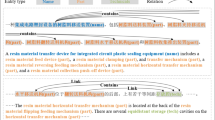Abstract
As an important part of information extraction, relationship extraction aims to extract the relationships between given entities from natural language text. Based on the pretraining model R-BERT, this paper proposes an entity relationship extraction method that integrates an entity dependency path and pretraining model, which generates a dependency parse tree by dependency parsing, obtains the dependency path of an entity pair via a given entity, and uses an entity dependency path to exclude information such as modifier chunks and useless entities in sentences. This model has achieved good F1 value performance on the SemEval2010 Task 8 dataset. Experiments on datasets show that dependency parsing can provide context information for models and improve performance.



Similar content being viewed by others
Availability of data and material
Data for this work were obtained from the web (accessed from www.semeval2.fbk.eu/semeval2.php).
References
Brin S (1998) Extracting Patterns and Relations from the World Wide Web[J]. Springer, Berlin Heidelberg, pp 172–183
Craven M, Kumlien J. Constructing Biological Knowledge Bases by Extracting Information from Text Sources[J]. Proceedings /. International Conference on Intelligent Systems for Molecular Biology; ISMB. International Conference on Intelligent Systems for Molecular Biology, 1999:77–86.
Golshan PN, Dashti HR, Azizi S. A study of recent contributions on information extraction. arXiv preprint arXiv:1803.05667, 2018.
Gu M, Gu Y, Luo W et al (2021) From text to graph: a general transition-based AMR parsing using neural network. Neural Comput and Applic 33:6009–6025
Guo XY, He TT, Hu XH, Chen QJ. Chinese Entity Relationship Extraction based on Syntactic and Semantic Features. Journal of Chinese Information Processing, 2014,183−189 (in Chinese with English abstract).
Hasegawa T, Sekine S, Grishman R. Discovering Relations among Named Entities from Large Corpora[C]. Proceedings of the Meeting on Association for Computational Linguistics, 2004:415-es.
Huang YY, Wang WY. Deep Residual Learning for Weakly-Supervised Relation Extraction[C]. Proceedings of the Conference on EMNLP 2017: 1803–1807
Ji GL, Liu K, He SZ, et al. Distant supervision for relation extraction with sentence-level attention and entity descriptions[C]. In: Proc. of the AAAI. 2017. 3060−3066
Katiyar A, Cardie C. Going out on a limb: Joint extraction of entity mentions and relations without dependency trees[C]. Proceedings of the Conference on Association for Computational Linguistics. 2017. 917−928
Li DM, Zhang Y, Li DY et al (2020) Review of entity relation extraction methods[J]. J Comp Res Dev 7:1424–1448
Lin Y, Shen S, Liu Z, et al. Neural relation extraction with selective attention over instances[C]. In: Proc. of the Meeting of the Association for Computational Linguistics. 2016. 2124−2133
Liu Q, Li Y, Duan H, Liu Y, Qin ZG (2016) A survey of knowledge mapping construction techniques. J Comp Res Dev 53:582–600 ((in Chinese with English abstract))
Peng H, Gao T, Han X, et al. Learning from Context or Names? An Empirical Study on Neural Relation Extraction[C]//Proceedings of the 2020 Conference on Empirical Methods in Natural Language Processing, November 16–20, 2020:3661–3672
Ren X, Wu Z, He W, et al. CoType: Joint Extraction of Typed Entities and Relations with Knowledge Bases[C]// the 26th International Conference. International World Wide Web Conferences Steering Committee, 2016:1015–1024
Soares L B, Fitzgerald N, Ling J, et al. Matching the Blanks: Distributional Similarity for Relation Learning[C]// Proceedings of the 57th Annual Meeting of the Association for Computational Linguistics. 2019
Wang Q, Wang Y, Zhou Y et al (2022) SSPSNet: a single shot panoptic segmentation network for accurate scene parsing. Neural Comput and Applic 34:677–688
Wu SC, He YF. Enriching Pre-trained Language Model with Entity Information for Relation Classification[C]// the 28th ACM International Conference. ACM, 2019:2361–2364.
Wu F, Weld D S. Open information extraction using Wikipedia[C]// ACL 2010, Proceedings of the 48th Annual Meeting of the Association for Computational Linguistics, July 11–16, 2010:118–127
Xu K, Feng Y, Huang S, Zhao D (2015) Semantic relation classification via convolutional neural networks with simple negative sampling[J]. Comp Sci 71:941–949
Zeng D, Liu K, Lai S, Zhou G, Zhao J. Relation classification via convolutional deep neural network[C]. Proceedings of the 25th Int’l Conf. on Computational Linguistics: Technical Papers (COLING 2014). 2014. 2335−2344
Zeng D, Liu K, Chen Y, et al. Distant supervision for relation extraction via piecewise convolutional neural networks[C]. Proceedings of the Conference on Empirical Methods in Natural Language Processing. 2015. 1753−1762.
Zhang D, Wang D. Relation classification via recurrent neural network. arXiv preprint arXiv:1508.01006, 2015.
Zhou GD, Su J, Zhang J, et al. Exploring various knowledge in relation extraction[C]. In: Proc. of the Conf. on Meeting of the Association for Computational Linguistics (ACL 2005). University of Michigan, 2002:419−444.
Funding
This work was supported by the National Defense Science and Technology Industrial Technology Research Project (JSQB2017206C002).
Author information
Authors and Affiliations
Contributions
Author have made equal contribution.
Corresponding author
Ethics declarations
Conflicts of interest
The authors declare no conflict of interest.
Additional information
Publisher's Note
Springer Nature remains neutral with regard to jurisdictional claims in published maps and institutional affiliations.
Rights and permissions
About this article
Cite this article
Yin, B., Sun, Y. Relationship classification based on dependency parsing and the pretraining model. Soft Comput 26, 8575–8583 (2022). https://doi.org/10.1007/s00500-022-07195-5
Accepted:
Published:
Issue Date:
DOI: https://doi.org/10.1007/s00500-022-07195-5




